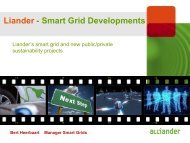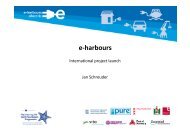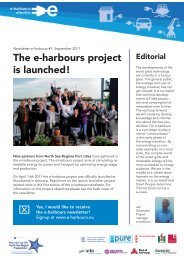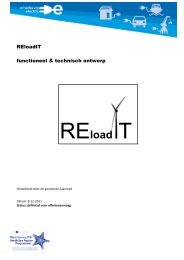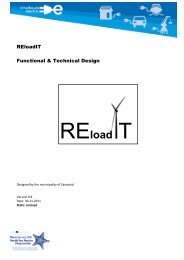renewable energy in zaanstad: from theory to practice - e-harbours
renewable energy in zaanstad: from theory to practice - e-harbours
renewable energy in zaanstad: from theory to practice - e-harbours
Create successful ePaper yourself
Turn your PDF publications into a flip-book with our unique Google optimized e-Paper software.
for the application of deep geothermal <strong>energy</strong>. The region South-Holland has a lot of potential with<br />
PRH. Zaanstad is less fortunately with its geothermal <strong>energy</strong> potential. The software <strong>in</strong>dicates the<br />
region around Zaandam as not suitable for geothermal <strong>energy</strong>. The region around Krommenie and<br />
Wormerveer has the most potential, with a PRH of 5.9 PJ/km2, a temperature of 77.5 °C at 2 km and<br />
a temperature of 176.7 °C at 5km depth.<br />
Figure 7. Overview of the potential of deep geothermal <strong>energy</strong> <strong>in</strong> the Netherlands (left) and <strong>in</strong> Zaanstad (right)<br />
Zaanstad<br />
The deployment of geothermal <strong>energy</strong> can be used by Zaanstad <strong>to</strong> supply (a part of) the heat<br />
demand of its municipality <strong>in</strong> a susta<strong>in</strong>able way. Shallow applications can be used for seasonal heat<br />
s<strong>to</strong>rage <strong>in</strong> comb<strong>in</strong>ation with grounds source heat pump, which consequently will lead <strong>to</strong> an <strong>in</strong>crease<br />
<strong>in</strong> the electricity consumption. Deep geothermal <strong>energy</strong> has some potential, but only <strong>in</strong> the northern<br />
region of Zaanstad. In the area of Wormerveer and Krommenie a potential heat recovery of 5.9<br />
PJ/km 2 is available. However, if this space is practical available and if this is cost effective requires<br />
further research.<br />
3.7 INFRASTRUCTURE<br />
The <strong>energy</strong> demand of Zaanstad is supplied by different <strong>energy</strong> carriers, i.e. transport fuels, natural<br />
gas and electricity. In context of Zaanstads <strong>energy</strong> policy, the municipality wants <strong>to</strong> replace the<br />
consumption of fossil fuels by <strong>energy</strong> <strong>from</strong> susta<strong>in</strong>able resources. This will <strong>in</strong>evitably lead <strong>to</strong> changes<br />
<strong>in</strong> the <strong>energy</strong> <strong>in</strong>frastructure. The impact of this transition on the heat and electricity <strong>in</strong>frastructure<br />
will now be reviewed.<br />
Heat<br />
The heat demand of Zaanstads residents is currently for a large part supplied by natural gas. In order<br />
<strong>to</strong> supply this heat demand <strong>in</strong> a susta<strong>in</strong>able way, Zaanstad has several options. Biomass is <strong>in</strong> <strong>theory</strong> a<br />
very promis<strong>in</strong>g option for Zaanstad because of its available sources, the problem however is that<br />
most of these sources are already used for other dest<strong>in</strong>ations. Zaanstad needs <strong>to</strong> negotiate with local<br />
16



